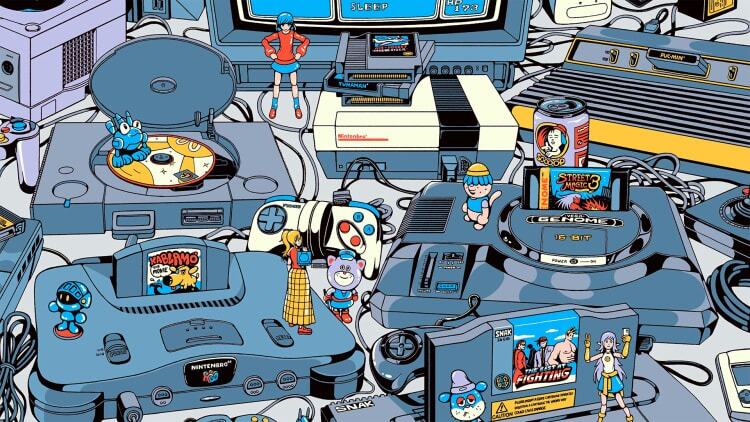- | 8:00 am
The best alternative to Sony’s $700 PS5 is this $36 book
Feeling nostalgic for the good old days of gaming hardware? Revisit them in Console Chronicles.

Last week, Sony unveiled the PS5 Pro—and its C suite–level price tag of $700. The prospect of shelling out so much coin for some frame rate upgrades and spec buffs managed to adequately piss off many players, while leaving others (raises hand) pining for the era of gaming when disc drives came standard and narratives unfolded on a CRT TV rather than a $4,300 OLED 4K AI-enabled rig or your cramped cellphone.
Not long after Sony’s reveal, coincidentally, I cracked open a galley of Lost in Cult: The Console Chronicles, and was transported to a time when gaming felt simpler. If you too are seeking a return to the halcyon days of video game hardware, this is where you’ll find it.
GETTING PERSONAL
Lost in Cult is a U.K.-based publisher dedicated to documenting the history, art and design of video games. Last year, it released A Handheld History: A Celebration of Portable Gaming. But rather than simply provide a veritable Wiki-style walkthrough of the Game Boy and other devices, the editors decided to focus on personal essays and other stories around the tech.
The book strongly influenced Lost in Cult’s approach to covering video game history going forward—“putting the old in conversation with the new to find a new path forward through well-trodden territory,” details Abram Buehner, who served as a key editorial overseer of The Console Chronicles, which was a collaboration between Lost in Cult and Time Extension/Nintendo Life publisher Hookshot Media.
Throughout the book you’ll find a comprehensive history of consoles—in addition to stories capturing the human and personal side of them, from tales of bootleg Sega Dreamcast titles to the magic of midnight launches that dominated 2000s-era gaming.
“What I want to know is why players carry particular games with them; what pieces of their past developers bring into their work,” says Buehner. “I think you have to understand all these different roles, perspectives, and eras to really appreciate why games have so quickly become such a driving force in global economics and entertainment.”

DESIGNING AGAINST NOSTALGIA
At one point or another, game consoles, print books, long-form essays, and bespoke art and design have all been framed in various states of decline or death. And so it’s perhaps a surprise to see them simultaneously firing on all cylinders in the book.
Buehner says that contrary to other gaming-related books that trade solely in nostalgia, or, say, the Switch release of Nintendo World Championships: NES Edition, with its throwback vector and vaporwave vibes, he wanted to avoid all of that. One reason: People like him in their twenties today weren’t around to play some of these games on the original systems. Rather, their nostalgia comes from rereleases farther down the line.
“I’ve experienced games history unmoored from its original context. To me, it’s all part of one big continuity—so we’ve designed [The Console Chronicles] to reflect that. Visually, we’re pulling from Japanese fashion magazines and looking to craft something transcendent.”

That manifests in art direction and illustration by Stephen Maurice Graham, and a design ecosystem that also utilizes macro and product photography to present a kaleidoscopic array of video game consoles and IP.
“Whenever I see a new illustration which pays homage to one of my favorite games, I’m able to see something I’ve seen a million times through new eyes,” Buehner adds. “That’s magic.”
CRUSHED CONSOLES
The book of course covers the classics—the various Nintendos, Xboxes, PlayStations, and so on. But some of the most fascinating reading details the systems failed or forgotten by time.
Like, say, the 1972 Magnavox Odyssey, the world’s first video game console. As Lewis Packwood writes in the book, “Humans first walked on the moon just three years before the Odyssey was released, and the console looks like it could well be a prop in Stanley Kubrick’s smash-hit 1968 film 2001: A Space Odyssey. Is the name a coincidence? Probably not.” Packwood adds that its legacy was just one game: Table Tennis. Atari took it and made it into the smash hit Pong.

Among the endless other featured lost consoles that look like cinematic bits of background retrofuturism, there’s also the ColecoVision—a device that perhaps most closely resembles a phone/answering machine combo, which, as Jack Yarwood details, is particularly overlooked when compared to the Atari 2600, but “brought the experience of console gaming closer to the arcade than ever before,” and also influenced the likes of the Nintendo Famicom. Without it, he writes, the video game industry would likely look very different today.
And then there’s the more known Sega Dreamcast (1998/99), which Buehner dubs “a forward-thinking failed console.” He adds that its built-in modem should have made it the system to bring online play to the masses—but it was hampered by its small game library, problematic controller, and the popularity of the PlayStation 2. “Had the Dreamcast succeeded, then perhaps Sega would be running in the hardware race alongside Sony and Nintendo instead of Microsoft,” he notes. “The Dreamcast was running Windows and using DirectX, so Microsoft had the institutional knowledge to grab the baton from Sega and keep running with the original Xbox.”
THE FUTURE OF THE GAME
So: In an era of $700 PS5s and all things mobile gaming, what does the future hold for consoles?
Buehner points out that around 2012 or 2013, there was a lot of talk about dedicated gaming systems being on the way out . . . but the meteoric rise of the PlayStation 4 in 2013 proved them all wrong.
Still, he thinks we may be nearer to those analysts’ predictions today. While the cloud-based gaming platform Google Stadia folded and Capcom’s iPhone projects have failed to take off, “I do see them as a glimpse into a future that relies less and less on home consoles. You could even argue that PlayStation’s PC ports and the runaway success of the Switch as a hybrid are also eroding the traditional console space.”
He’s not yet ready to call it, though.
“When you look at the desire for boutique physical media releases in the fields of music and film, I think you see a route forward for physical games and, in turn, physical consoles to play them on,” he says.
But, ultimately, “As a player, I’ll chase the games.”
And that’s the key to it all—and as The Console Chronicles chronicles, perhaps what has always been at the heart of all those storied machines over the past five decades, too.







































